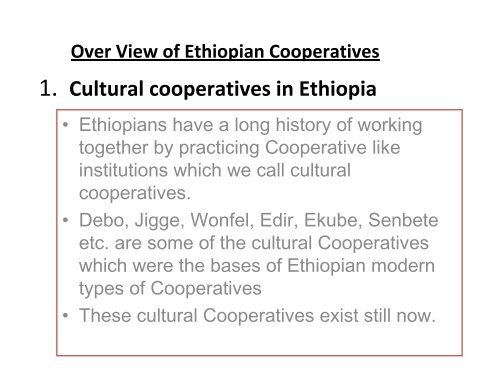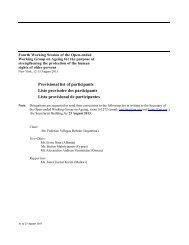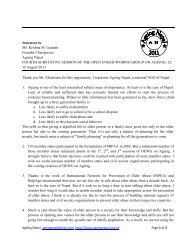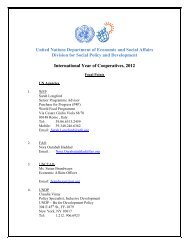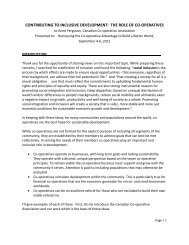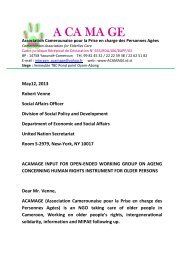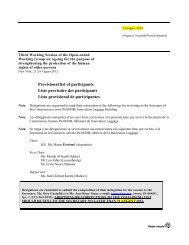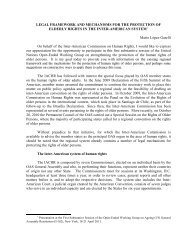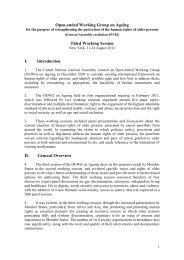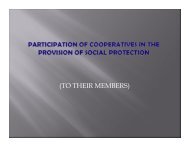1. Cultural cooperatives in Ethiopia - Division for Social Policy and ...
1. Cultural cooperatives in Ethiopia - Division for Social Policy and ...
1. Cultural cooperatives in Ethiopia - Division for Social Policy and ...
Create successful ePaper yourself
Turn your PDF publications into a flip-book with our unique Google optimized e-Paper software.
Over View of <strong>Ethiopia</strong>n Cooperatives<br />
<strong>1.</strong> <strong>Cultural</strong> <strong>cooperatives</strong> <strong>in</strong> <strong>Ethiopia</strong><br />
• <strong>Ethiopia</strong>ns have a long history of work<strong>in</strong>g<br />
together by practic<strong>in</strong>g Cooperative like<br />
<strong>in</strong>stitutions which we call cultural<br />
<strong>cooperatives</strong>.<br />
• Debo, Jigge, Wonfel, Edir, Ekube, Senbete<br />
etc. are some of the cultural Cooperatives<br />
which were the bases of <strong>Ethiopia</strong>n modern<br />
types of Cooperatives<br />
• These cultural Cooperatives exist still now.
2. The History of Modern types<br />
Cooperatives <strong>in</strong> <strong>Ethiopia</strong><br />
2.<strong>1.</strong> Cooperatives at the time of<br />
Emperor Hailesellasie<br />
• Modern types of <strong>cooperatives</strong> <strong>in</strong><br />
<strong>Ethiopia</strong> started 50 years be<strong>for</strong>e at the<br />
time of Emperor Hailesellasie<br />
• The emergence of modern types of<br />
cooperative at that time was to solve an<br />
employment problem specially<br />
unemployment of retired workers<br />
/military <strong>for</strong>ces.
• To facilitate the establishment of modern<br />
<strong>cooperatives</strong> cooperative decree 44/1961 <strong>and</strong><br />
proclamation 241/1966 were issued.<br />
• To be a cooperative member a person was required<br />
to have l<strong>and</strong>, so voluntary <strong>and</strong> open membership<br />
pr<strong>in</strong>ciple was not fully practiced.<br />
• Individuals who have no l<strong>and</strong> at all or those who<br />
have a small amount of rural l<strong>and</strong> had no a chance<br />
of be<strong>in</strong>g a cooperative member.<br />
• Based on the Decree <strong>and</strong> proclamation Government<br />
employees <strong>in</strong> the Urban areas had a chance to<br />
organize sav<strong>in</strong>g <strong>and</strong> credit <strong>cooperatives</strong>. Example:-<br />
EPCO, Tele, Air l<strong>in</strong>es workers SACCOS.<br />
• Except the urban SACCOS, all types of <strong>cooperatives</strong><br />
established at that time were abolished by the<br />
Derge regime.
2.2. Cooperatives at the time of Military (Derge)<br />
Regime<br />
• Abolished all <strong>cooperatives</strong> (except<br />
Urban SACCOS) <strong>and</strong> established new<br />
<strong>cooperatives</strong> based on <strong>Social</strong>ist ideology<br />
(They were used as a meanse of<br />
promot<strong>in</strong>g socialist ideology)<br />
• Issued proclamation No. 138/78<br />
• Compare with the <strong>cooperatives</strong> of<br />
Emperor regieme, the <strong>cooperatives</strong><br />
types <strong>and</strong> number of <strong>cooperatives</strong> were<br />
more.
• The <strong>cooperatives</strong> were not organized by<br />
members voluntar<strong>in</strong>ess (b/c there were direct<br />
<strong>and</strong> Indirect en<strong>for</strong>cement) members sense of<br />
ownership <strong>and</strong> belong<strong>in</strong>gness were very<br />
m<strong>in</strong>imal or absent.<br />
•The then political elites had strong arms on<br />
<strong>cooperatives</strong> management, governance,<br />
f<strong>in</strong>ance <strong>and</strong> property adm<strong>in</strong>istration.
•Almost all of the producers <strong>cooperatives</strong> <strong>and</strong><br />
many of other types of <strong>cooperatives</strong> were<br />
•<br />
abolished or highly weakened when the<br />
government issued a mixed economy policy<br />
which gave a chance <strong>for</strong> cooperative members to<br />
decide on their <strong>cooperatives</strong>.<br />
•The then producers Cooperative were abolished<br />
with <strong>in</strong> a very short time.
2.3. Cooperative at present (EPRDF<br />
led Government)<br />
• When EPRDF won the Military Derge <strong>and</strong><br />
started lead<strong>in</strong>g the Country, Cooperative<br />
members who had no Confidence/Trust on<br />
their Cooperative <strong>and</strong> Cooperative leaders<br />
who were corrupted <strong>and</strong> misappropriated the<br />
cooperative money <strong>and</strong> property <strong>in</strong>itiated<br />
members to abolish their <strong>cooperatives</strong> <strong>and</strong><br />
looted the property of the Cooperatives.
• Because of these many Cooperatives were<br />
abolished, weakened<br />
• At that time it was belived that Cooperatives are<br />
Organizations found only <strong>in</strong> <strong>Social</strong>ist system, so s<strong>in</strong>ce<br />
Derge who was a socialist oriented Government has<br />
collapsed after Derg why cooperative was the<br />
question<br />
• Because of the extension service given at that time,<br />
Agricultural production <strong>in</strong>creased <strong>and</strong> faced<br />
market<strong>in</strong>g problems. To solve the market<strong>in</strong>g<br />
problems of agricultural products, agricultural<br />
<strong>cooperatives</strong> were taken as a means of solv<strong>in</strong>g this<br />
problem by the policy makers.
• Organiz<strong>in</strong>g Cooperatives based on members<br />
voluntary participation was started.<br />
• The Agricultural Cooperatives proclamation<br />
No. 85/94 has played a great role <strong>in</strong> Re‐<br />
Organiz<strong>in</strong>g Agricultural Cooperatives.<br />
• The establishment of Cooperative desk <strong>in</strong> the<br />
prime M<strong>in</strong>isters office <strong>and</strong> <strong>in</strong> the Respective<br />
Regional Council offices.<br />
• The establishment of Regional Cooperative<br />
office, bureau <strong>in</strong> all the regions.
• The Cooperative proclamation No. 147/98<br />
<strong>and</strong> Amendment of proclamation No. 402/96<br />
• In most of policies <strong>and</strong> economic <strong>and</strong> social<br />
strategic documents of the Government,<br />
attentions were given to Cooperatives.<br />
• The establishment of Federal Cooperative<br />
commission (FCC) Federal Cooperative Agency<br />
(FCA) at the National level.
3. The Role of Government Cooperative<br />
promotion Structures<br />
• Cooperative promotion structures (Agencies,<br />
bureax, offices etc) are established<br />
throughout the country (Federal, Regional,<br />
Zonal, District, Village level (Kebele)<br />
• The role of all these structures is<br />
‐ give technical supports<br />
‐ Regulate the activities of Cooperatives
‣Audit<br />
‣Inspection<br />
‣Give legal service<br />
services (no payment <strong>for</strong><br />
the services)<br />
• Organize, strengthen <strong>cooperatives</strong> <strong>and</strong><br />
promote the Cooperative ideas<br />
• Capacity build<strong>in</strong>g = Tra<strong>in</strong><strong>in</strong>g <strong>and</strong> others
4. Organizational structures <strong>and</strong><br />
achievements of <strong>Ethiopia</strong>n<br />
Cooperatives.<br />
4.<strong>1.</strong>Organizational structures of Cooperatives<br />
• In <strong>Ethiopia</strong> the cooperative organizational<br />
structure is envisaged to have 3 ladders.<br />
<strong>1.</strong> Primary Cooperatives<br />
• Ten or more <strong>in</strong>dividuals voluntarily <strong>for</strong>m<br />
primary <strong>cooperatives</strong>.
2. Cooperation of Cooperatives (Cooperative union)<br />
• Two or more voluntary primary <strong>cooperatives</strong> <strong>for</strong>m a<br />
cooperative union.<br />
• Cooperative Unions are established when there are<br />
problems that cannot be solved by primary<br />
<strong>cooperatives</strong>.<br />
3. National Cooperative Federation<br />
• Established by two or more voluntary<br />
Cooperative unions.<br />
• To establish national Federations, there must<br />
be a problem that could not be solved by<br />
<strong>in</strong>dividual cooperative unions.
Cooperative league<br />
• Established by two or more voluntary National<br />
Cooperative Federation.<br />
• Cooperative league Functions will be<br />
‣Adm<strong>in</strong>istrative activities<br />
‣Capacity build<strong>in</strong>g<br />
‣Advocacy<br />
‣etc.<br />
• It will not have bus<strong>in</strong>ess activities<br />
• Its source of f<strong>in</strong>ance is expected to be members<br />
f<strong>in</strong>ancial contributions.<br />
• When cooperative league is established the<br />
Government’s role will be limited to regulatory<br />
functions only. The promotional activities will<br />
be transferred to the league.
4.2. Current Cooperatives data of the<br />
country<br />
<strong>1.</strong> Primary <strong>cooperatives</strong><br />
• No of primary <strong>cooperatives</strong> = 43255<br />
• Members of primary cooperative = 6566694<br />
‣ Men = 5153271=78.48%<br />
‣ Women= 1413423 = 2<strong>1.</strong>52%<br />
• Total Capital = 2,927,656,020.00
Among these<br />
• Multipurpose Ag <strong>cooperatives</strong> 7702 = 17.81% =<br />
68.34.1<br />
• Sav<strong>in</strong>g <strong>and</strong> Credit Cooperative 10270=23.74%<br />
= 12.81%<br />
• Hous<strong>in</strong>g <strong>cooperatives</strong> 7587= 17.54%=0.76%<br />
• Agricultural types of <strong>cooperatives</strong><br />
3995=9.24% = 3.46%<br />
• Consumer <strong>cooperatives</strong> 1502= 3.47% =<br />
6.48%<br />
• Multipurpose Agricultural Coop + Agriculture<br />
type cooperative<br />
7702 + 3995= 11697 = 27.04 = 7<strong>1.</strong>8%
2. Cooperative union<br />
• No of Cooperative unions = 278<br />
• No of member primary <strong>cooperatives</strong> = 7843<br />
• Capital = 1,373,602,639<br />
Among the unions<br />
• Multipurpose Ag cooperative unions (Ag market<strong>in</strong>g<br />
cooperative unions) 115 = 4<strong>1.</strong>37%<br />
• Sav<strong>in</strong>g <strong>and</strong> credit cooperative union 69 = 24.82%<br />
• Agriculture <strong>and</strong> Agricultural type of cooperative<br />
unions 66 = 23.74%
• Consumer Cooperative union 18 = 6.47%<br />
• Multipurpose Ag cooperative union + Agricultural<br />
type cooperative union = 181=65.58%<br />
3. National Cooperative Federation<br />
• The establishment of National Cooperative<br />
Federation is on process<br />
• 4 Regional Cooperative Federations are<br />
established <strong>in</strong> the three Regions.
4.National Cooperative league<br />
•Will be established when two national<br />
cooperative Federations are established.<br />
4.3. Summary of the activities of<br />
<strong>Ethiopia</strong>n Cooperatives <strong>and</strong> their outcomes<br />
Cooperatives market<strong>in</strong>g activities<br />
‣Almost all of the <strong>Ethiopia</strong>n <strong>cooperatives</strong><br />
per<strong>for</strong>m market<strong>in</strong>g activities<br />
‣The Market<strong>in</strong>g activities of <strong>Ethiopia</strong>n<br />
<strong>cooperatives</strong> can be summarized
• Collect members products <strong>and</strong> sell <strong>in</strong> bulk<br />
<strong>and</strong> br<strong>in</strong>g better money to members<br />
• Supply <strong>in</strong>puts required by members <strong>for</strong><br />
their production<br />
• Supply to members consumable items<br />
(Agricultural products, <strong>in</strong>dustrial products,<br />
other consumable items) <strong>and</strong> Stabilize the<br />
market
By per<strong>for</strong>m<strong>in</strong>g the above market<strong>in</strong>g activities<br />
<strong>cooperatives</strong> <strong>in</strong>crease the <strong>in</strong>come of members<br />
<strong>and</strong> contribute to the Economic Development of<br />
the country by<br />
‣ Pay<strong>in</strong>g the prevail<strong>in</strong>g market price to<br />
members<br />
‣ Pay<strong>in</strong>g dividends (Second payment)<br />
‣ Supply quality <strong>in</strong>puts <strong>and</strong> consumable items<br />
at a reasonable price
Cooperatives are meanses to <strong>in</strong>crease production <strong>and</strong><br />
productivity of members <strong>and</strong> even non members that<br />
contribute to the economic growth of the country<br />
Cooperatives are play<strong>in</strong>g a great role <strong>in</strong> sav<strong>in</strong>g<br />
mobilization of members <strong>and</strong> solve members f<strong>in</strong>ancial<br />
problems through their sav<strong>in</strong>g <strong>and</strong> credit <strong>cooperatives</strong><br />
Cooperative role <strong>in</strong> employment<br />
Direct employment –higher employs<br />
Organiz<strong>in</strong>g <strong>in</strong>dividual under <strong>cooperatives</strong> <strong>and</strong><br />
solve the problems that cannot be solved<br />
<strong>in</strong>dividually <strong>and</strong> create a better work<strong>in</strong>g<br />
atmosphere.
Role of <strong>Ethiopia</strong>n <strong>cooperatives</strong> <strong>in</strong> solv<strong>in</strong>g<br />
hous<strong>in</strong>g problems<br />
Cooperatives <strong>in</strong>volvement <strong>in</strong> developmental<br />
activities <strong>in</strong> their localities.<br />
‣Construction of health stations<br />
‣Potable water service<br />
‣Construction <strong>and</strong> ma<strong>in</strong>tenance of schools<br />
‣Construction of animal health posts<br />
‣Construction/ma<strong>in</strong>tenance of rural roads<br />
‣Give transportation services
• Cooperatives agro process<strong>in</strong>g activities<br />
• Cooperatives role <strong>in</strong> Food Security <strong>and</strong><br />
Poverty Reduction<br />
• Cooperatives <strong>in</strong>volvement <strong>in</strong> cross cutt<strong>in</strong>g<br />
issues<br />
‣ Soil <strong>and</strong> water conservation‐<br />
Af<strong>for</strong>staion<br />
‣ HIV/Aids<br />
‣ Gender ma<strong>in</strong> stream<strong>in</strong>g
<strong>1.</strong> Lack of trust <strong>and</strong> sense of ownership by<br />
members of cooperative<br />
2. F<strong>in</strong>ancial limitations.<br />
3. Run by elected committees rather that<br />
tra<strong>in</strong>ed <strong>and</strong> skilled manpower (Manager).<br />
4. Corruption <strong>and</strong> misappropriation of F<strong>in</strong>ance<br />
<strong>and</strong> other resources.<br />
5. The technical supports given by the<br />
organiz<strong>in</strong>g bodies is m<strong>in</strong>imal.


